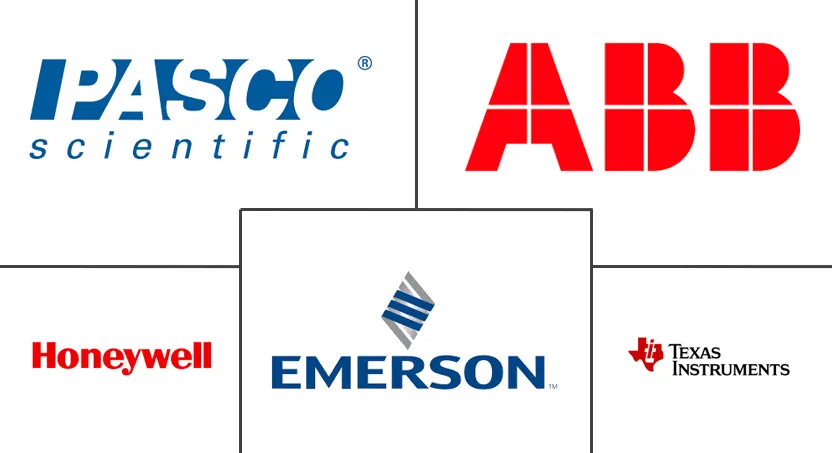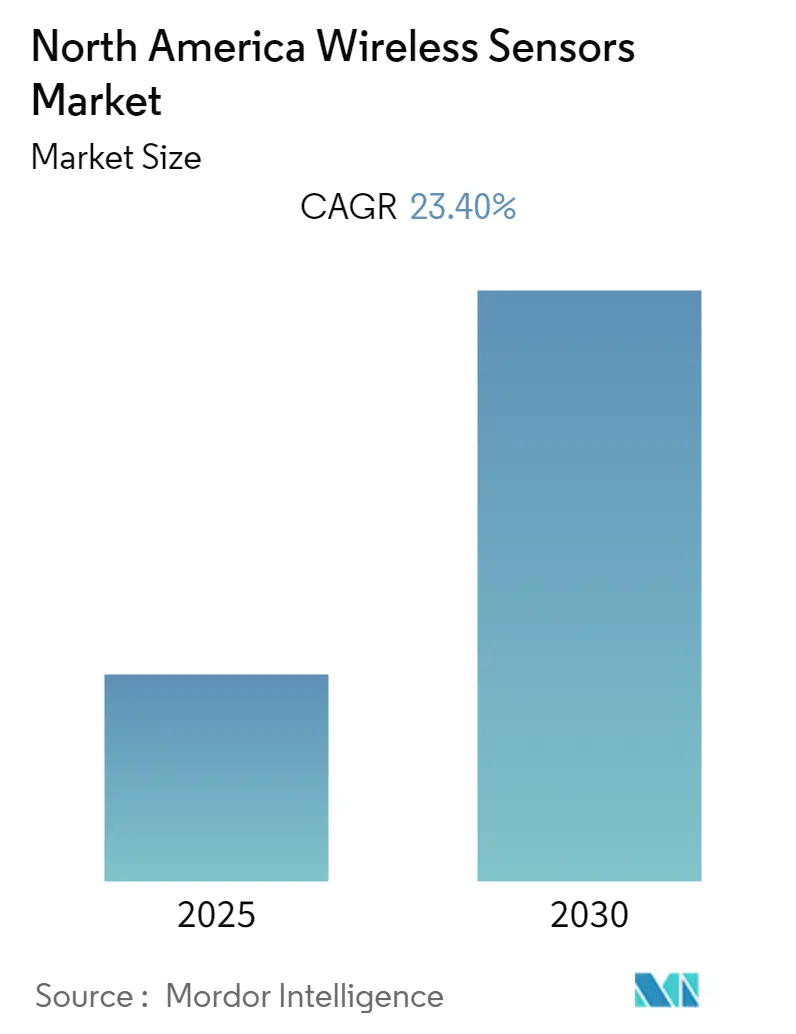
North America Wireless Sensors Market Analysis by Mordor Intelligence
The North America Wireless Sensors Market is expected to register a CAGR of 23.4% during the forecast period.
- Wireless sensors help to automate communication between critical systems and mitigate future problems for different utilities. For instance, water leak sensors can be mounted on walls to detect plumbing failures or pipes that may burst in the winter. Similarly, wireless rope sensors are being used in server rooms and data centers to detect the presence of water near computer hardware.
- These sensors also support disaster management efforts. For instance, in Texas, wireless sensors are being installed on bridges to detect water levels above a certain threshold, thus, indicating potential flash flooding in the area. Wireless vibration sensors are used in industrial plants with large machinery to predict equipment failures before they occur.
- Many companies are investing in wireless technologies in the region, which are cost-effective, safe, and convenient. For instance, SPM Instrument AB, a provider of condition monitoring technology and products, announced the release of Airius, a range of wireless vibration sensors for remote monitoring of industrial equipment. This sensor is a wireless, battery-powered vibration sensor ideal for remote condition monitoring of standard production equipment, such as pumps and fans.
- The increasing military spending across the region paves the way for technologies like drones/unmanned aerial vehicles (UAVs). In addition, the usage of wireless sensors in traditional fighter jets with high-end navigation systems is increasing significantly. The factors mentioned above are creating an exponential demand for wireless sensors in volumes as well.
- Further, the defense sector in the region is embracing wireless sensor technology, as these sensors can help organizations monitor their premises, identify suspicious activity, and track valuable assets. Moreover, they also find applications in banks. They can turn wireless push buttons into panic buttons for employees and retailers to install wireless window sensors on every building access point.
North America Wireless Sensors Market Trends and Insights
Automotive is Expected to Hold Significant Market Share
- Automotive vehicles have undergone various changes over the last few decades. Previously, cars used to work with basic electrical systems that offered power for headlights and spark plugs. As technology progressed, cars were fitted with the latest gadgets, such as radios, alarms, and wipers. Various technological advancements have also been made for vehicles’ safety, such as airbag deployment. The increase in these sensor-dependent features has driven engineers to develop more accurate sensors with automotive applications in mind.
- Currently, the two significant trends for the automotive sector are electrification and automation. The emergence of electric vehicles in the industry has dramatically impacted the demand for wireless sensors in the long term. More electric cars mean an increase in demand for sensors, a surge in sensors for used battery monitoring, and various positioning and detection of moving parts of automobiles.
- Moreover, with the increasing use of electric vehicles, technology pioneers like Qualcomm have developed efficient wireless charging technology for cars. This wireless charging technology offers convenience for users to charge their vehicles at wireless charging stations, parking lots, or at home efficiently. The company has also achieved transfer efficiency of more than 90% with a single primary base pad. The company believes that the technology can be further improved for better efficiency and more straightforward implementation in the future.
- As the use cases of sensors continue to increase in automobile applications to support ADAS, infotainment, and autonomous driving systems, the need for interface specifications is apparent. It is expected to be critical for future demand.
- As ADAS applications evolve and become more complex, there has been an increased need for effective methods to present safety alerts and other relevant information to the driver. Head-up displays (HUDs) are among the few emerging solutions for consolidating ADAS data into a centralized screen that allows the driver to keep the eyes on the road while viewing alerts and warnings that appear on the windshield time.
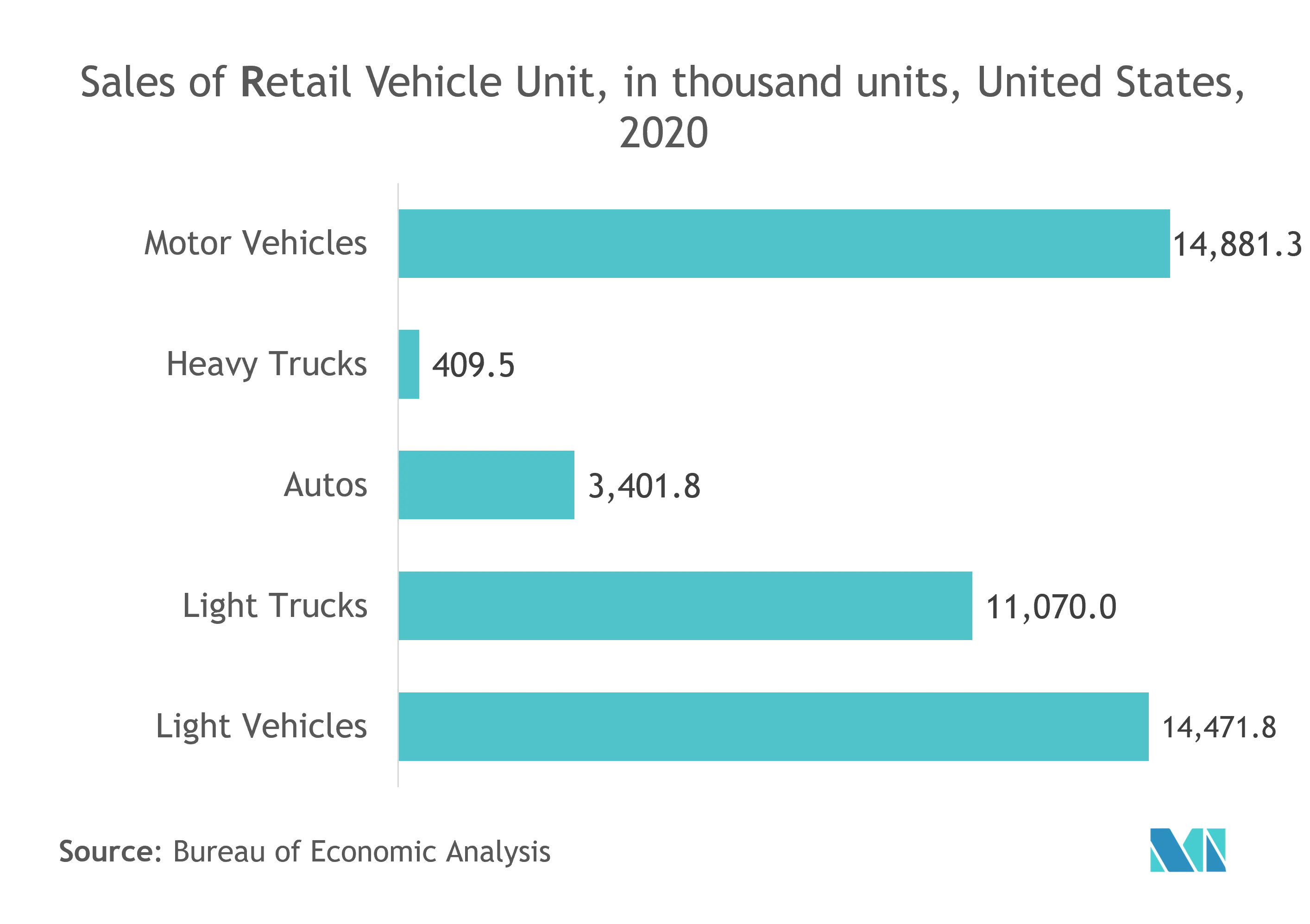
United States Accounts for the Largest Market Share
- The growth of the wireless sensors market is driven by the application in the various end-user industries. Manufacturers invest in R&D activities to improve the accuracy and reliability of wireless sensors. Wireless sensors are used for data monitoring and other similar functions and in building automation, military and defense, and other industries, like food and beverage and material handling.
- The key drivers influencing the wireless sensors market are the increasing need for new renewable energy development, energy sources, and other rapid technological advancements in the United States. They are also a vital component in smart grids for remote monitoring of transformers and power lines where they are put into service to monitor line temperature and weather conditions.
- Moreover, critical wireless sensor vendors in the United States adopt product innovation strategies to cater to advanced offerings across the industries. For instance, in Feb 2020, Kryton International Inc., a company known for innovative and valuable concrete technologies, launched its new Maturix smart concrete sensors. The Maturix smart concrete sensor is the first truly wireless concrete monitoring sensor in the region.
- The United States also has the highest adoption of automation and smart devices in almost every industry. Owing to a high rate of industrialization, the country is a dominant market for smart homes and smart offices. The area has also witnessed the most increased adoption of wireless sensors for various industry verticals compared to the world.
- Further, with changing dynamics in the industry, automotive manufacturers are moving toward electric vehicles production to meet the needs of advanced consumers. The use of electric vehicles in the United States has risen rapidly, significantly augmenting the demand for wireless sensors designed for automotive applications.
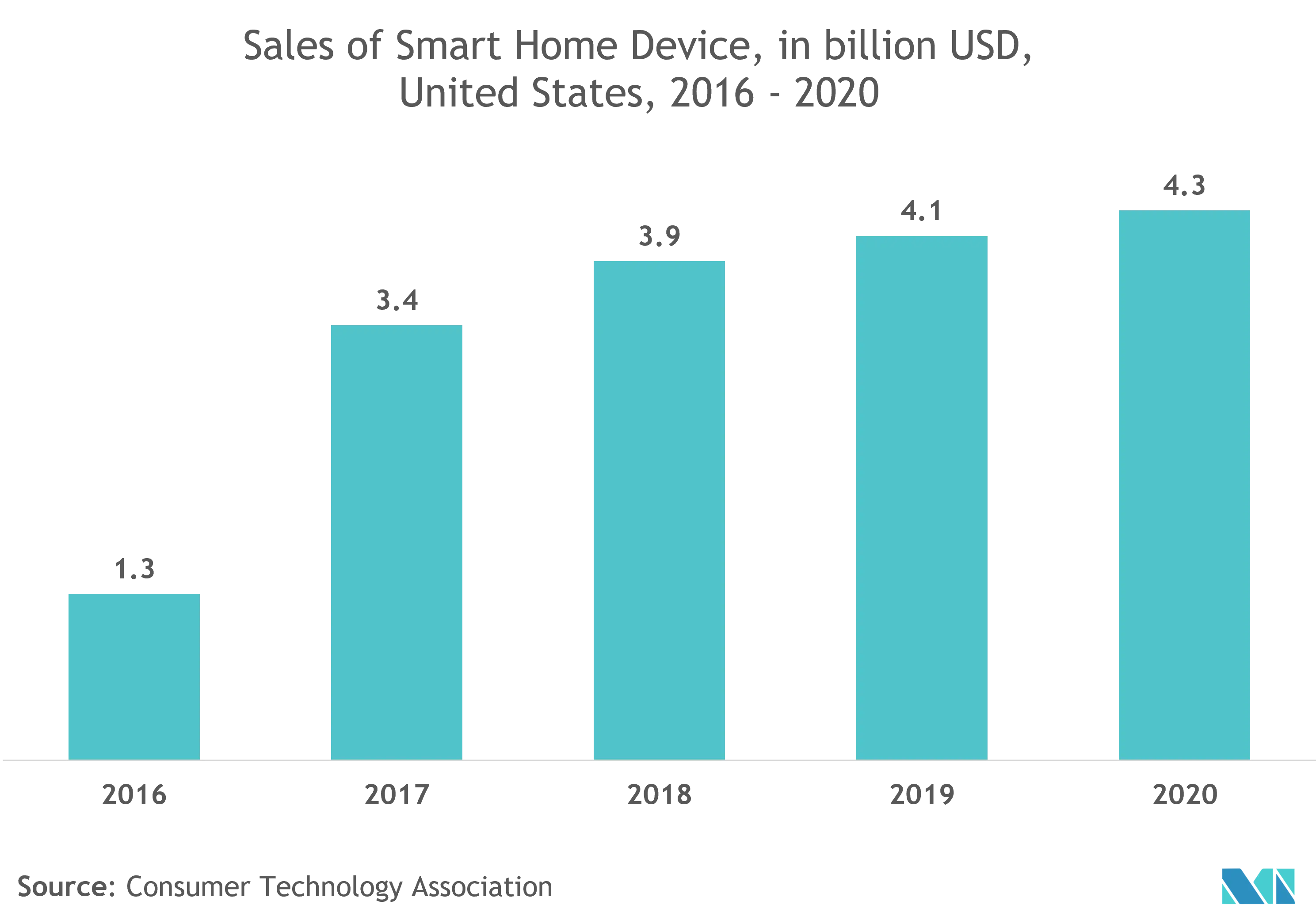
Competitive Landscape
The North American wireless sensor is highly competitive owing to multiple vendors providing wireless sensors to the domestic and international markets. The market appears to be moderately fragmented, and the major players with a prominent share in the market are focusing on expanding their customer base across international countries. Additionally, these companies are continuously innovating their products to increase their market share and increase their profitability. Some of the recent developments in the market are:
- August 2021 - A team of researchers from UMass Lowell and Northeastern University developed a wireless sensor network to detect coronavirus in the air, wastewater in real-time. The project is called "DiSenDa," which stands for Disease Surveillance with Multi-Modal Sensor Network and Data Analytics. The probes attached to the sensors have been specifically designed to detect the presence of biomarkers for SARS-CoV-2 in the air and wastewater samples.
- January 2021 - Everactive, a technology company that builds the Internet of Things (IoT) solutions, raised USD 35 million in funding to develop its battery-free wireless sensors. The funds will be used to accelerate sales, marketing, and product development of the company's battery-free wireless sensors for industrial applications. Moreover, Everactive's end-to-end monitoring solutions are aimed at high-volume industrial assets that are currently unmonitored or under-monitored due to sheer volume.
North America Wireless Sensors Industry Leaders
-
Honeywell International Inc.
-
Emerson Electric Co.
-
Texas Instruments Incorporated
-
ABB Ltd
-
Pasco Scientific
- *Disclaimer: Major Players sorted in no particular order
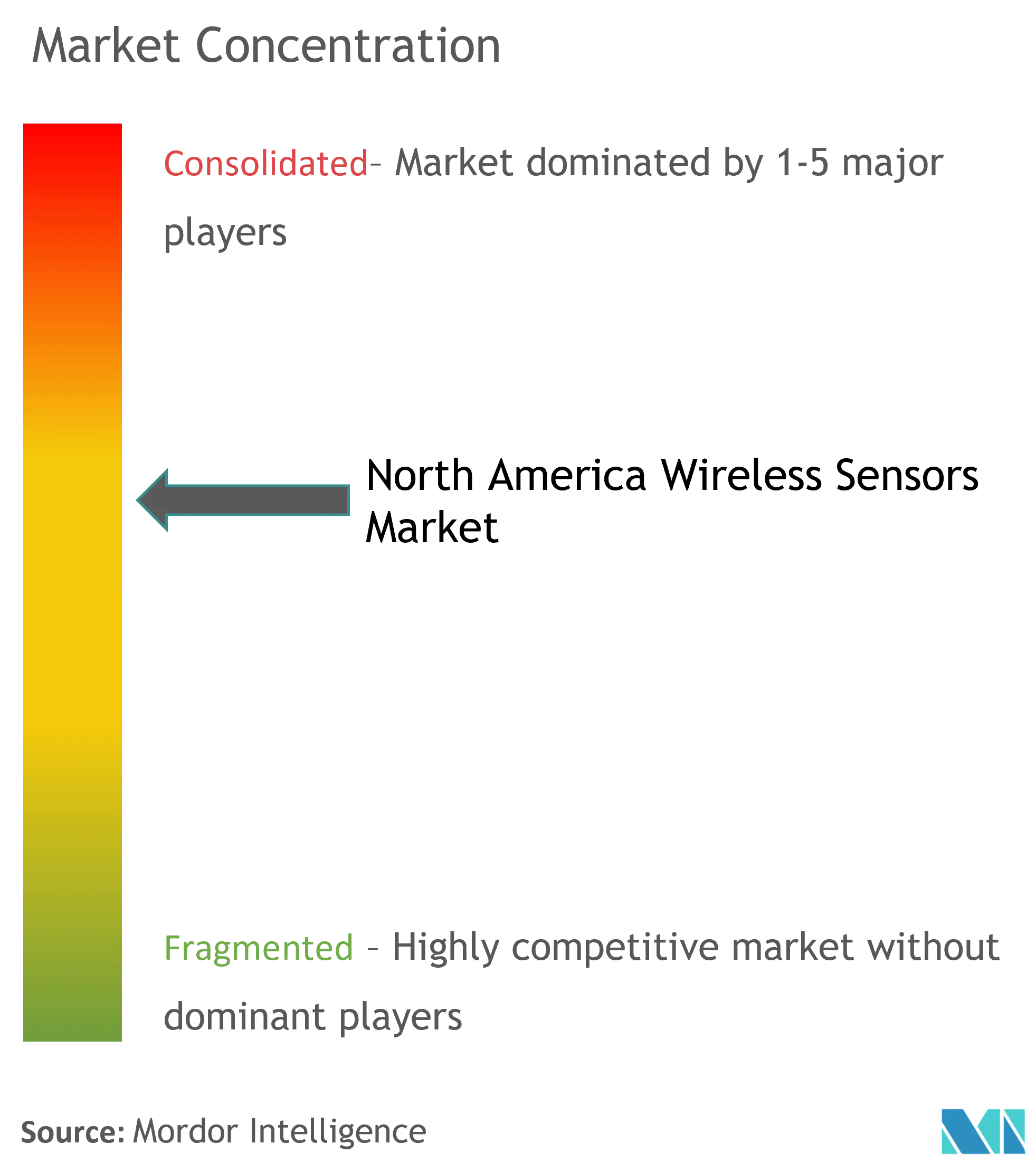
Recent Industry Developments
- March 2021 - MIT researchers have developed wireless sensing and AI system that could help improve patients' techniques with self-administered medications such as inhalers and insulin pens. The wireless sensors could detect errors in self-administered medication, ranging from swallowing pills and injecting insulin. According to MIT, users can install the system in their homes, and it can alert patients and caregivers to medication errors and potentially reduce unnecessary hospital visits.
- January 2021 - Swift Sensors, a provider of industrial IoT sensor solutions, announced the launch of its secure wireless vaccine storage unit monitoring and alert system to enable medical facilities and pharmacies to monitor COVID-19 vaccine storage temperatures remotely, automate data logging, and respond quickly in case of an equipment problem or power failure.
North America Wireless Sensors Market Report Scope
The study characterizes the wireless sensors market based on the type of wireless sensors, the end-user industry, and the country. Wireless sensors are measurement tools for monitoring and recording the physical conditions of the environment. They are equipped with transmitters that convert signals from process control instruments into a radio transmission. These sensors have various applications in numerous sectors, such as automotive, healthcare, aerospace, etc. These have formed the part of the study in considering the end-user industry estimation. The scope of the study is currently focused on key regions, such as the United States and Canada. Further, to arrive at the overall market projections, the study analyzes the impact of COVID-19 and the investment scenario and other macro-economic factors.
| Pressure Sensor |
| Temperature Sensor |
| Chemical and Gas Sensor |
| Position and Proximity Sensor |
| Other Types |
| Automotive |
| Healthcare |
| Aerospace and Defense |
| Energy and Power |
| Food and Beverage |
| Other End-user Industries |
| United States |
| Canada |
| By Type | Pressure Sensor |
| Temperature Sensor | |
| Chemical and Gas Sensor | |
| Position and Proximity Sensor | |
| Other Types | |
| By End-user Industry | Automotive |
| Healthcare | |
| Aerospace and Defense | |
| Energy and Power | |
| Food and Beverage | |
| Other End-user Industries | |
| By Country | United States |
| Canada |
Key Questions Answered in the Report
What is the current North America Wireless Sensors Market size?
The North America Wireless Sensors Market is projected to register a CAGR of 23.4% during the forecast period (2025-2030)
Who are the key players in North America Wireless Sensors Market?
Honeywell International Inc., Emerson Electric Co., Texas Instruments Incorporated, ABB Ltd and Pasco Scientific are the major companies operating in the North America Wireless Sensors Market.
What years does this North America Wireless Sensors Market cover?
The report covers the North America Wireless Sensors Market historical market size for years: 2019, 2020, 2021, 2022, 2023 and 2024. The report also forecasts the North America Wireless Sensors Market size for years: 2025, 2026, 2027, 2028, 2029 and 2030.
Page last updated on:
North America Wireless Sensors Market Report
Statistics for the 2025 North America Wireless Sensors market share, size and revenue growth rate, created by Mordor Intelligence™ Industry Reports. North America Wireless Sensors analysis includes a market forecast outlook for 2025 to 2030 and historical overview. Get a sample of this industry analysis as a free report PDF download.
